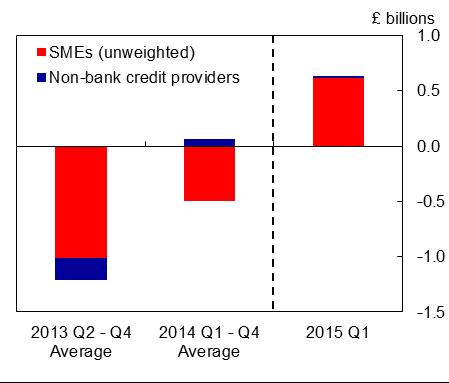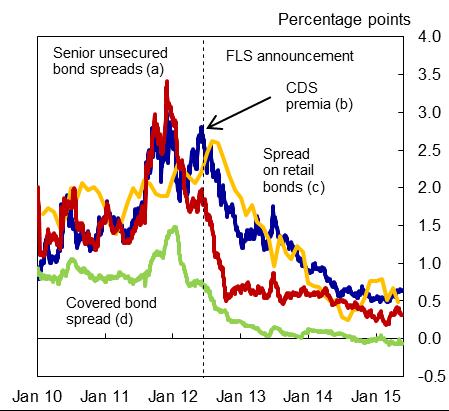The Bank of England has today published data on the use of the Funding for Lending Scheme (FLS) showing, for each group participating in the FLS Extension, the net quarterly flow of lending to UK small and medium-sized enterprises (SMEs) and non-bank credit providers (NBCPs), and the amount borrowed from the Bank in the first quarter of 2015.
The Bank has today published data on the use of the Funding for Lending Scheme (FLS) showing, for each group participating in the FLS Extension, the net quarterly flow of lending to UK small and medium-sized enterprises (SMEs) and non-bank credit providers (NBCPs), and the amount borrowed from the Bank in the first quarter of 2015.
During the first quarter of 2015, the number of groups participating in the FLS Extension was 34. Of these, 10 participants made drawdowns of £3.1bn in total. Participants also repaid £1.5bn, taking total outstanding drawings to £57.3bn.
Net lending by FLS Extension participants to SMEs was £0.6bn in the first quarter of 2015. This compares with quarterly net lending to SMEs in 2014 Q4 by FLS participants of -£0.8bn, while the quarterly average for 2014 was -£0.5bn
Quarterly net lending to SMEs and NBCPs by FLS Extension participants

Source: Bank of England. (a) For more details of the sector definitions within FLS see the Market Notice. (b) Note that the number of groups participating in the FLS Extension fell to 34 in 2015 Q1, from 38 at end-2014.
A number of institutions expanded their lending in 2015 Q1 and further borrowing allowances of £4.9bn have been generated, spread across 16 participants.
Aggregate net lending to SMEs (i.e. including lending by banks and building societies not participating in the FLS) was also positive in 2015 Q1. This is part of a broader improvement in lending to all non-financial businesses, as discussed in the May 2015 Inflation Report.3
Over the past few years, credit conditions have improved for SMEs. This has continued in 2015. According to the FSB Voice of Small Business Index, availability of credit to small businesses has risen in 2015 Q1. And in the Bank’s 2015 Q1 Credit Conditions Survey (CCS), lenders reported that spreads over reference rates for medium-sized companies fell significantly over the quarter. The CCS also reported that spreads were broadly unchanged for smaller companies however, while the Bank’s network of Agents report that some small companies continued to find it difficult to borrow from banks.4
The improvement in corporate credit conditions in part reflects the significant fall in bank funding costs that has occurred since the launch of the FLS. Over the first quarter of 2015, the level of funding costs remained low. The FLS Extension will continue to support lending to SMEs in 2015.
UK banks’ indicative longer-term funding spreads
Sources: Bank of England, Bloomberg, Markit Group Limited and Bank calculations. (a) Constant-maturity unweighted average of secondary market spreads to swaps for the major UK lenders’ five-year euro senior unsecured bonds, or, where not available, a suitable proxy. (b) Unweighted average of the five-year senior CDS premia for the major UK lenders. (c) Sterling only, average of two and three-year spreads on retail bonds. Spreads over relevant end-month swap rates. Constant-maturity unweighted average of secondary market spreads to swaps for the major UK lenders’ five-year euro-denominated covered bonds, or, where not available, a suitable proxy. |

